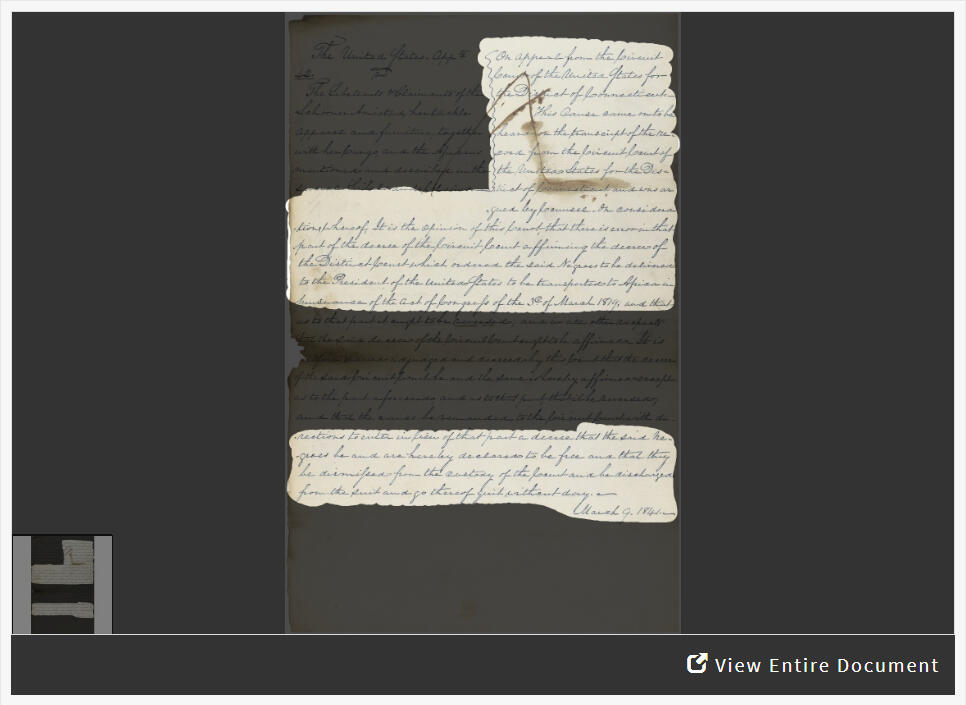Suggested Teaching Instructions
Use this activity during a unit of study on the judicial system or the issue of slavery. For grades 11-12. Approximate time needed is 30 minutes.
Divide students into pairs or small groups. Review the definition of
jurisdiction before beginning the activity. If you haven't previously discussed the facts of the case in class, share the following background:
In February of 1839, Portuguese slave hunters abducted a large group of Africans from Sierra Leone and shipped them to Havana, Cuba, a center for the slave trade. This abduction violated all of the treaties then in existence. Two Spanish plantation owners, Pedro Montes and Jose Ruiz, purchased 53 Africans and put them aboard the Cuban schooner Amistad to ship them to a Caribbean plantation. On July 1, 1839, the Africans seized the ship, killed the captain and the cook, and ordered Montes and Ruiz to sail to Africa.
Instead, Montes and Ruiz steered the ship north; and on August 24, 1839, the Amistad was seized off Long Island, NY, by the U.S. brig Washington. The schooner, its cargo, and all on board were taken to New London, CT. The plantation owners were freed and the Africans were imprisoned on charges of murder.
Although the murder charges were dismissed, the Africans continued to be held in confinement and the case went to trial in the Federal District Court in Connecticut. The plantation owners, government of Spain, and captain of the Washington each claimed rights to the Africans or compensation.
President Van Buren was in favor of extraditing the Africans to Cuba. However, abolitionists in the North opposed extradition and raised money to defend the Africans. Had it not been for the actions of abolitionists in the United States, the issues related to the Amistad might have ended quietly in an admiralty court. But they used the incident as a way to expose the evils of slavery and generate significant opposition to the practice.
Attorneys hired by abolitionists to represent the Africans wrote, in court documents: "...each of them are natives of Africa and were born free, and ever since have been and still of right are and ought to be free and not slaves..." They argued that they were not a part of a Spanish domestic slave trade and instead had been forcibly kidnapped from the African coast. And further that, while suffering “great cruelty and oppression” on board the Amistad, they were “incited by the love of liberty natural to all men” to take possession of the ship by force and seek asylum somewhere.
The district court ruled that the case fell within Federal jurisdiction and that the claims to the Africans as property were not legitimate because they were illegally held as slaves. The U.S. District Attorney filed an appeal to the Supreme Court.
In the trial before the Supreme Court, the Africans were represented by former U.S. President, and descendant of American revolutionaries, John Quincy Adams. For 8 ½ hours, the 73-year-old Adams passionately and eloquently defended the Africans' right to freedom on both legal and moral grounds, referring to treaties prohibiting the slave trade and to the Declaration of Independence.
Before beginning the activity, provide students with a transcript of the
United States Constitution. Prompt students to carefully examine the highlighted sections of the document in the activity – the Supreme Court's decision – and answer the questions provided. (Remind them to click the arrow and magnifying glass icons in the blue menu bar at the bottom of the document to take a closer look and also to click the
View Entire Document button in the bottom right corner of the document for specific citation information.)
- What court had original jurisdiction?
- Which court was next to hear the case? What was the result?
- What was the Supreme Court's decision in United States v. Libellants of Schooner Amistad?
- According to the Constitution, why does the Supreme Court have the authority to hear this case? Provide the exact article and section. (Article III, Section 2)
Once students have finished writing their responses, hold a class discussion, allowing them to share their thoughts.
Ask students to click the
When You're Done button. They will be instructed to look at a world map and plot the course of the schooner
Amistad from Africa to the United States based on its stops:
- Sierra Leone
- Havana, Cuba
- Puerto Principe, Camaguey, Cuba
- Culloden Point, Montauk, NY
- New Haven, Connecticut
Ask them if they agree with the decision that the United States had the authority to hear the case.
Discuss with them that the Supreme Court ordered the immediate release of the Africans, ruling that they were free individuals — because they had been (in the opinion of the court) kidnapped and transported illegally, they had never been slaves. Share Justice Joseph Story's quote: "...it was the ultimate right of all human beings in extreme cases to resist oppression and to apply force against ruinous injustice." After sharing the quote, ask them if they agree with Justice Story's assertion in the case.
For further information on
United States v.
Libellants of Schooner Amistad, see
"Incited by the Love of Liberty" The Amistad Captives and the Federal Courts featured in the Spring 2003 edition of the National Archives
Prologue Magazine.





